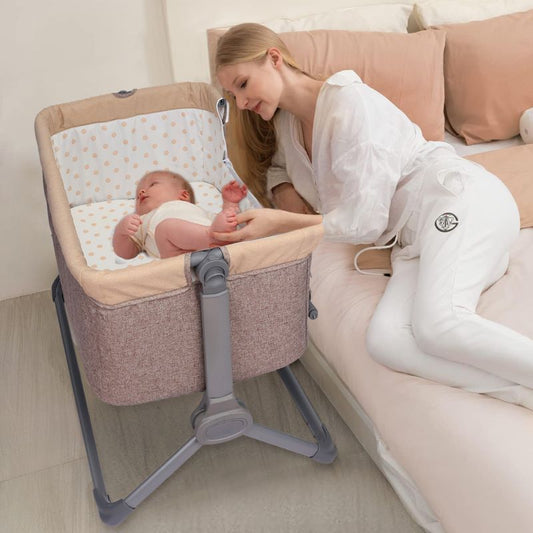How to relieve gas in newborns naturally: 9 Essential Tips

Table of Contents
Quick Summary:
Is your baby fussy even after being fed and put to sleep? Understanding the reasons behind their discomfort can be overwhelming for new parents. Babies transition from the calm womb environment to a demanding world, leading to digestive struggles and gas buildup. Distinguishing between colic and gas is crucial, as their symptoms and causes vary. Discover effective remedies and tips to soothe your little one’s discomfort and create a peaceful atmosphere.Imagine a scenario where you have timely fed the baby and put them to rest, but they showcase an inconsolable discomfort by being fussy, despite the caregivers' undivided attention.
Many a times, new parents undergo a dilemma to understand the causes for the baby’s crankiness and end up feeling overwhelmed to soothe them.
At such events, it is very essential to comprehend the right triggers for their unsettling behavior.
Why does it happen?
Babies experience a change of environment from the womb to the outer world. The atmosphere inside the womb is calm and controlled, which does not require the digestive and respiratory systems to function at full efficiency.
However, outside the womb, due to the shift in their environment, their respiratory, digestive systems, and overall immune system demand efficiency, which is still developing in the babies.
Due to this, when babies begin breastfeeding, bottle-feeding, hungry-gulping, gurgling, or even crying or undergoing colic, they unintentionally swallow air.
This becomes the main reason for the gas buildup in them and requires caregivers’ infant gas remedies to soothe them of this unwanted pain.
Colic v/s Gas
|
Aspect |
Colic |
Gas |
|
Definition |
Severe and fluctuating abdominal pain associated with infants. |
Bloating and discomfort are caused by air in the digestive system. |
|
Cause |
The exact cause is unknown but believed to be related to digestive immaturity, overstimulation, sensitivity to certain foods, or inability to self-soothe. |
Swallowing air during feeding, digestion of certain foods, or bacterial fermentation. |
|
Onset |
Begins within the first few weeks of life and peaks around6- 8 weeks. |
It can happen anytime, especially after eating or swallowing air. |
|
Duration |
It can last for several hours, days, and weeks, and usually begins in the evening. |
Short-lived but can cause discomfort for varying periods, depending on the situation. |
|
Symptoms |
Intense crying, fussiness, clenching, drawing knees to the chest, and difficulty calming. |
Bloating, passing gas, discomfort, gurgling sounds, and burping. |
|
Frequency |
Often occurs in episodes, with babies seeming to cry for long periods, often without relief. |
Occasional discomfort or bloating after feeding or crying. |
|
Age of occurrence |
Primarily affects infants between2 weeks and 3 -4 months of age. |
It can affect babies and adults of all ages. |
|
Associated factors |
May be triggered by overstimulation, undigested milk, or stress. |
It can be caused by swallowing air, food intolerance, or digestive issues. |
|
Treatment |
Calming techniques, swaddling, rocking, feeding adjustments, or medication. |
Burping, feeding changes, tummy massage, or medication. |
|
Relief |
Resolves on its own as the baby’s digestive system matures. |
Resolves with burping, passing gas, or after a bowel movement. |
Let us now understand more about the probable causes and home remedies for infant gas pain.
A. Recognizing Signs Of Gas In Babies
The first step towards providing the baby with gas relief is identifying the symptoms shown by the baby. This includes:
- Constant and inconsolable fussiness or crying, mostly followed by feeding. This might be due to the built-up gas, causing them discomfort.
- Depicting clenched fists to relieve the gas and ease the pain.
- Drawing up their legs towards their stomach to provide them relief.
- The gurgling sound in the stomach or intestines indicates the presence of gas.
- The stomach appears bloated or hard due to the trapped air inside.
- Baby is constantly arching their back and swirling due to pain.
- Frequent burping
- Depicting straining and grunting noises to ease the pain.
Now, let us discuss how to relieve gas in newborns naturally to soothe their pain.
B. Effective Techniques To Relieve Baby Gas
Babies relax and relieve the trapped gas by the following methods.
1. Burping During And After Feeding
Infants begin developing gas right from their breastfeeding or bottle-feeding sessions. This is because the gurgling sound made by them during feedings also encourages the intake of air, which becomes trapped inside their stomach.
Tip: Always ensure to feed the baby before they are excessively hungry. This prevents them from hurried-milk-gurgling, thus eliminating the risk of potential air intake.
Besides, it is important to understand the right latching techniques during breastfeeding and choose the right age-appropriate nipples for bottle-feeding. There are also certain anti-colic designed baby milk bottles and sippers to prevent gas intake by the babies.
Such a simple step could relieve them of unnecessary gas buildup.
In addition, it is also essential to make them burp before, during, and after their feeding sessions.
- Breastfeeding: When switching from one breast to another.
- Bottle-Feeding: After every 60- 90ml of feeding.
Tip: If the baby starts crying while feeding or moves their head away from the breasts or bottle, it is also an indication of gas troubling them.
Techniques for burping your baby
- Position your baby on your shoulder by supporting the baby with one hand and patting or rubbing the baby’s back gently.
- Place the baby on your lap and hold them in a way that they are slightly forward. Also, support their chin with one hand and rub or pat their back gently to relieve them of gas.
- Lay the baby flat on your lap by carefully balancing the baby with one hand and rubbing or patting the baby’s back gently. However, avoid the situation of baby spit-up in this position.
2. Proper Feeding Positions
Adapting an optimum feeding position helps a lot in the prevention of gas buildup in infants.
The 45-degree angle Feeding
Always ensure to place the baby at a 45-degree angle while feeding them to prevent gas buildup. This is because this position assists the gravity, thus filling the nipple with milk, reducing the chance of air entering their digestive tract.
Besides, it also promotes better digestion by preventing acid reflux, which encourages the milk to flow backwards into the esophagus.
In addition, this position also prevents the risk associated with ear or various respiratory infections. This is important because of their still-developing bodily systems.
Tip: Always ensure to keep the baby in an upright position for 20 to 30 minutes after every feeding to prevent acid reflux.
3. Tummy Time
This is one of the most effective home remedies for infant gas pain and colic. It refers to placing the baby on their tummy while they are awake. The body pressure on their abdomen promotes the release of the trapped air inside their stomach.
This happens due to the breaking up of the gas bubbles, owing to their body pressure, thus facilitating healthy digestion in babies. Also, their various leg movements, wiggling and twirling, etc., during this time, help them ease the gas.
Tip: Always begin the tummy time for 1- 2 minutes and then increase the timing gradually to prevent unnecessary discomfort for them.
4. Gentle Tummy Massage
This is also one of the most effective infant gas remedies to stimulate the digestive system and relieve the trapped gas.
It just requires clockwise circular motion on the lower abdomen, aligning with the natural intestine direction, thus helping to release the trapped gas and support bowel movement.
The “I Love You” Stroke
- I: Begin from the lower left abdomen and move your hands upwards from the lower belly towards the first rib.
- L: Next, start with the lower right abdomen and move your hands upwards and then across the stomach, forming an L shape.
- U: Start from the lower right abdomen and make a U shape from the lower to the upper belly and then again lower, reaching the lower left abdomen.
C. Home Remedies For Gas Relief
Home remedies are considered one of the leading traditional Indian treatments for infant gas relief.
1. Asafoetida (Hing) Application
This is one of the most beneficial ingredients to promote digestive aid and prevent bloating, besides also having loads of antimicrobial properties.
Process: Prepare a thick paste of asafoetida, warm water, ghee or mustard oil, and apply it onto the naval or rub it gently on the baby’s belly in a clockwise motion.
Caution: Avoid applying the paste on the naval area, in case the umbilical cord is still intact, to prevent the risk of infection.
2. Warm Baths
Bathing the baby with lukewarm water encourages muscle relaxation and promotes stress reduction in the baby, thus contributing to the passage of trapped gas in their tiny tummy.
In addition, it also provides the baby with a calm and soothing environment for their overall relaxation.
Tip: Limit the bath time to 10 to 15 minutes to prevent dry skin and the risk of cold in babies.
3. Mustard Oil Massage
Massaging the babies with lukewarm mustard oil is a traditional Indian treatment for infant gas relief. This is because it promotes digestive stimulation, thus preventing gas buildup and constipation, besides, protecting the babies due to its anti-bacterial properties.
Tip: Ensure to massage the oil in the clockwise direction on the belly to relieve any discomfort and repeat it for a few minutes.
Caution: Consult the pediatrician before it’s use, in case the baby shows the symptoms of eczema or has any open wounds.
D. Preventive Measures
These are an added precaution to eliminate all the possible causes of gas intake by the baby.
1. Monitoring Maternal Diet
While there is a belief that certain foods taken by the mom during breastfeeding cause gas buildup in the stomach, according to research, it is considered a myth.
This is because the source of breastmilk is the mother’s blood, formed by her nutrition, not her diet directly. Also, breastfeeding requires loads of nutritious diet for the mother, and enlisting the food items causing gas could be subjective, as that depends upon the individual.
So, the mothers could eliminate certain foods to prevent gas buildup in them, but directing it towards the baby’s healthy digestion is yet to be researched.
2. Choosing The Right Feeding Equipment
This helps in providing the children with the right feeding tools to prevent gas buildup in them. It includes investing in:
- Anti-colic milk bottles and sippers, which not only prevent the accumulation of trapped air, but also reduce spit-up.
- Slow-flow nipples for younger babies and fast-flow nipples for older babies to adapt to their feeding habits.
- The nipple design resembles the breast nipples to promote healthy and comfortable latching in the babies.
E. When to Consult a Pediatrician
Certain home remedies are sufficient to provide the baby with gas relief. However, it is always beneficial to watch out for the signs for immediate medical consultation, like:
- Extreme and persistent fussiness and crying.
- Black or dark colored stools, followed by blood.
- Constipation
- Loss of appetite and sound sleep.
- Low weight gain
- Signs of colic that do not diminish.
- Inactive and lethargic baby
- Fever
F. Conclusion
Gas build-up begins as early as two weeks in the babies and gradually diminishes as their immune system adapts to their regular feeding habits. It is always beneficial to follow the prevention of gas buildup, rather than curing it later.
Also, although it can be easily cured with certain home remedies, it is very important to look for the signs indicating something serious in the babies by consulting the pediatrician.
Also Read:


















